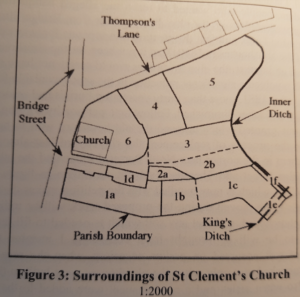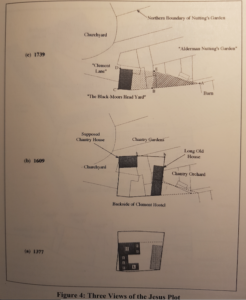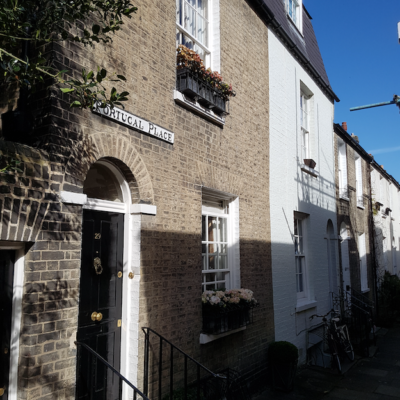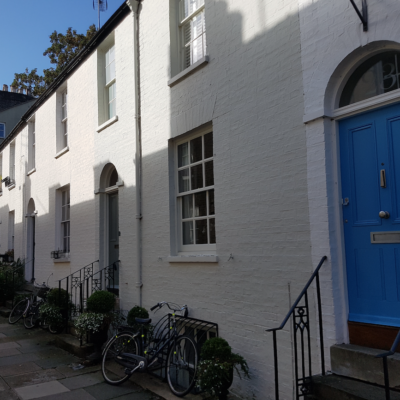Search by topic
- archaeology
- Building of Local Interest
- charity
- church
- crime
- dressmaker
- fire
- Great Eastern Railway
- Listed building
- Mapping Relief
- medieval
- oral history
- poverty
- Public House
- Rattee & Kett
- Religious House
- Roman
- scholar
- school
- Then and Now
- tudor
- women
- work
- world war one
- world war two
Search by text
8 Portugal Place (14 Clement Lane)
History of 8 Portugal Place
For details see T E Faber ‘Intimate History of St Clement’s’.
The plot of 8 Portugal Place is (2a), a plot of ground by the churchyard.
Before 1267: there is an undated charter which records a gift of several rents to the nuns of St. Radegund by William Corde, including 3s ‘from land in the which ]William de Furcis] holds in the parish of St Clement which lies between land of Geoffrey Gybon and land of Hareflet and extends from the road as far as he king’s ditch. The Hareflet area is labelled (5).
1373 two 14th cent. leases granted by the nuns of St Radegund refer to property in this area. The first was to Richard Milde capellanus, John de Kelesseye, cooper and his wife Avisia. The second was granted in 1377 to John and Avisia only. Richard Milde became vicar of St Clement’s in 1353 but by 1373 Adam de Walsoken had taken over the role. In fact it seems likely that Richard was no longer vicar in 1365.
1377 this lease describes in considerable detail the house that already stood on the tenement and the new house which John and Avisia contracted to build. The existing house consisted of ‘a good hall on the noprth side of the tenement with a solar adjoining the said hall occupying the full width of the tenement facing the churchyard .. under which solar are three storeroom of which one door opens into the hall and two doors into the churchyard with a kitchen adjoining the said solar on the south side of the said tenement and two storerooms as though under one roof with the hall on the north side of the tenement.‘
1401 Adam de Walsoken complained that there was no house for the vicar to live in. In 1402 the nuns granted Adam and successor vicars the old house on the site as a parsonage.
1471 parsonage falls into decay. Lease granted to ‘William Dack clericus’ but house not mentioned.
1473 – 1531 benefice held by John Damelot and then Reginald Aspes. They were fellows of King’s Hall and St John’s respectively and would have lived in college.
1568 Thomas Ventris
1608 lessee Hugh Jones the younger, tailor; he built two adjoining houses on a different part of the plot, and then sold out to John Trott.
1614 John Trott
1618 Thomas Trott (son)
1640 John Trott (son)
1739 Thomas Nutting, merchant. See 1739 map on diagram. His plot is indicated by the polygon ABCDE.
1771 Thomas Willett, a gardener.
1785 Thomas Willett. The two old houses were got rid of and a single house was built which survives today. Thomas Willett died in 1808 aged 76.
1808 house and garden taken over by Sussums who had a greengrocery business on Bridge Street.
1816 Elizabeth Sussum renewed lease
1830 on her death transferred to William Sussum and he sold it to a cook at St John’s.
1833 cook sold it to Juner Perry Lawrence, wine merchant
1959 Royal Commission on Historical Monuments Survey of Cambridge: formerly the vicarage of St Clements, has rendered timber framed walls and tiled roofs. It was built in the 17th cent., improved in the 18th, and has since been modernised.
1913
Harry Godwin Legge, painter and paperhanger
1962
Mrs L A Legge
Contribute
Do you have any information about the people or places in this article? If so, then please let us know using the Contact page or by emailing capturingcambridge@
License
This work is licensed under CC BY-NC-SA 4.0










